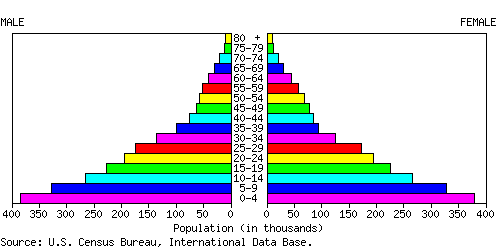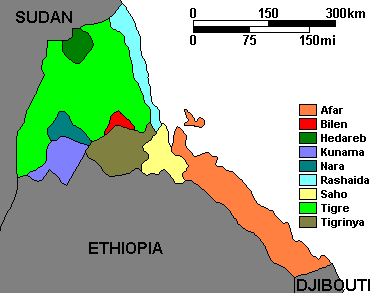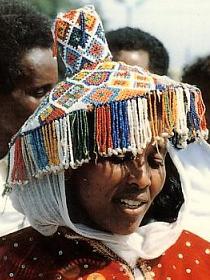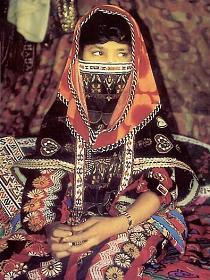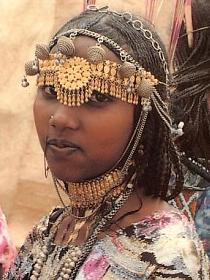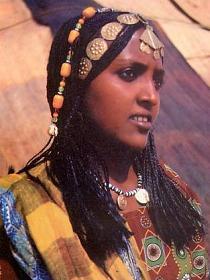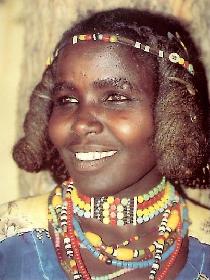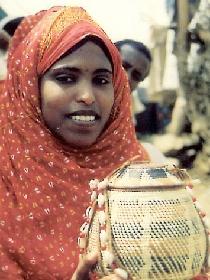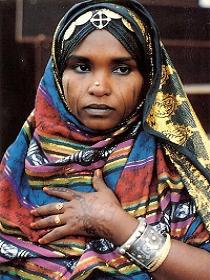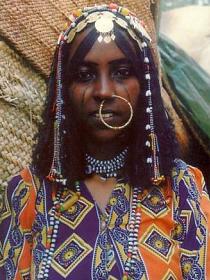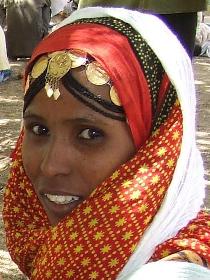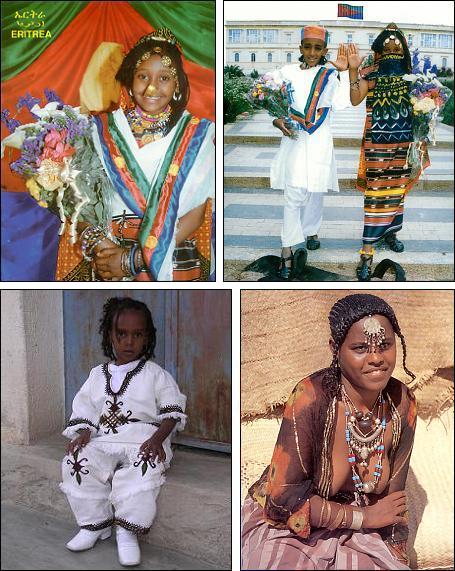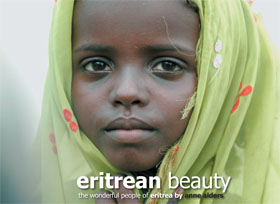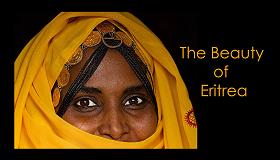Map of Eritrea
Location and geography
Eritrean history
Border conflict with Ethiopia
Political structure
Eritrean anthem
Economy & currency
Climate
People
Languages
Religion
Health care
Transport
Cuisine
News, links, books and more
Asmara (Asmera)
Agordat (Akordat)
Assab (Asseb)
Barentu
Dahlak islands
Dekemhare (Decemhare)
Ghinda (Ginda)
Keren (Cheren)
Massawa (Massauwa)
Mendefera (Adi Ugri)
Nakfa (Nacfa)
Semenawi Bahri (Filfil)
Tessenei
(Teseney)
The people of Eritrea
Population: 4,561,500 (2005 estimate)
Age structure:
0-14 years: 44.8% (male 1,023,900; female 1,019,400
15-64 years: 51.9% (male 1,170,800; female 1,194,700)
65 years and over: 3.3% (male 74,300; female 78,400)
(2005 estimate)
Eritrea population pyramid (age and sex distribution) for 2003
Population growth rate: 2.51% (2005 estimate)
Birth rate: 38.62 births/1,000 population (2005 estimate)
Death rate: 13.53 deaths/1,000 population (2005 estimate)Sex ratio:
At birth: 1.03 male/female
Under 15 years: 1.00 male/female
15-64 years: 0.98 male/female
65 years and over: 1.05 male/female
Total population: 0.99 male/female (2005 estimate)Infant mortality rate: 74.87/1,000 live births
(2005 estimate)Life expectancy at birth:
Total population: 58.0 years
Male: 61.0 years
Female: 59.5 years (2005 estimate)Total fertility rate: 5.61 children born/woman
(2005 estimate)
Eritrea's nationalities
Eritrea's nine nationalities Tigrinya *) 2,230,000 50% Central highlands of Maakel and Debub Tigre **) 1,208,000 27% Western lowlands across the northern mountains to the coastal plains Saho **) 242,000 5% Red sea coast (Foro) and the hinterland south of Asmara and Massawa and the highlands as far as Hazumo Valley Afar **) 215,000 5% Also known as Dankils, along the southeastern Red Sea coast and on the Dahlak islands Hedareb **) 202,000 4% Also known as T'badwe in western Barka (Tessenei) and Sahel Kunama 144,000 3% Around Barentu Bilen **) 112,000 2% In and around Keren Nara **) 107,000 2% Also known as Baria, on the western slopes and Barka plains Rashaida **) 40,000 1% Northern Red sea coast Total 4,500,000 100% *) predominantly Christian
**) predominantly MuslimJiberti Muslims regard themselves as an additional (tenth) nationality.
Another ethic group is the Tokharir, migrant Nigerians who have settled on the banks of the Gash river on their way to or from Mecca.
Eritrea's nine nationalities Tigrinya woman Rashaida woman Afar woman Tigre woman Kunama woman Saho woman Nara woman Hedareb woman Bilen woman One heart Women
Eritrean women played a central role in liberating the nation in 1991 and in defending it when it came under renewed Ethiopian attack in 1998-2000. Because of the important role women played in the society and economy, the Eritrean government has sought to ensure their full and equal participation while eliminating the disadvantages that many of the women experience. The National Union of Eritrean Women (NUEW) with its 200,000 members is an umbrella organization upholding the rights of women throughout Eritrea and the Diaspora and securing women's participation in the Eritrean society.
"Victory to the masses"
Mass participation has become a vigorous aspect of Eritrean nation building. It was the success of the Eritrean liberation movement fighting against Ethiopian imperialism. Not only in the military field, but also in building an Eritrean "grass roots" politics of self-government. In absolute contrast with Sudan, with its still raging civil war, the warring clans of Somalia, shooting each other to pieces, and ethnic based liberation movements in Ethiopia, Eritrea's nine ethnic groups live in harmony and peace.
High levels of popular participation in the country's reconstruction and development are the hallmark of Eritrea's post-independence growth. at the same time, instances of crime or corruption have remained lower than anywhere else in the world. This speaks to the high levels of social cohesion and civic pride that under gird the social and economic development process.
The National Service, written into Eritrea's Constitution as an obligation of citizenship, requires all women and men over eighteen to undergo six months of military training and a year of work on national reconstruction. The value of the National Service Program is that it compensates for Eritrea's lack of capital and reduces Eritrea's dependence on foreign aid, while welding together Eritrea's diverse society. It also places women in a condition of heightened gender equality for eighteen months, as service in the EPLF had done during Eritrea's war of independence.
The Diaspora
With a million Eritreans in exile from a total population of 4 million, this presents the phenomenal scenario that one out of every five Eritreans lives abroad. Thousands of Eritreans have been forced into exile because of their opposition to Ethiopia's annexation of their country in 1962. Young people were sent away for fear of forced conscription into the Ethiopian army and to avert the daily cruelties of the 1961-91 Ethiopian occupation. Attacks on civilians suspected of supporting the ELF and EPLF also led to a vast exodus of refugees.
The majority of the exiles walked, some fore hundreds of miles to the Sudan, where half a million remain as refugees. Another 250.000 are scattered across the globe in Europe, Canada, the United States and closer to their home in Saudi Arabia (100.000), the Middle East, Kenya and Ethiopia (100.000). Eritreans abroad remain staunchly loyal to their motherland and their families. These exiles raised much of the financial support for the thirty-year liberation struggle, and faithfully continue to assist family members back home both monetarily and materially.
Eritrea - diversity and unity - young Eritrean women in traditional clothes.
Eritrea, in some respects, was the way I had dreamed all of Africa might be one fine day. Never in my life had I felt a greater sense of community on a national scale. Nor had I seen a place with such wide-open arms and so generous a heart.
Julia Stewart - Eccentric Graces
Perhaps Eritrea's greatest resource is its people. Though impoverished, the nation has from the outset showed self-reliance, vigor and independence. Eritrea is not about to become anyone's vassal and this attitude has elicited both passionate admiration and furious exasperation from visitors, aid workers and international organizations alike. Towards the traveler, Eritreans show exceptional politeness, hospitality and friendliness.
Lonely Planet, Ethiopia and Eritrea, second edition
the wonderful people of Eritrea - Anne AldersThe Beauty of Eritrea - Johan Gerrits
